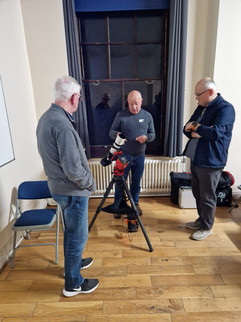Astrophotography Workshop - 30 November 2023
- Paul May

- Nov 30, 2023
- 2 min read
Per ardua ad astra
Unless of course you attended this excellent astrophotography workshop in which Mike Meynell significantly reduced the pain involved for us neophytes in capturing images of the stars and other celestial objects.
Tricks of the trade
Mike began by describing the potential of stand-alone digital cameras and their optimal settings. They are especially suited for large field of view image capture such as star trails, aurora, and the milky way. A couple of excellent tricks of the trade were described for removing the effects of light pollution involving respectively subtraction images and overexposure.

Lucky imaging
Planetary and deep sky objects require a telescope acting effectively as a telephoto lens in front of the digital camera. Longer focal length (high f number) setups are capable of the greater magnification suitable for planetary imaging, whilst shorter focal length (low f number) ones provide the larger field of view typically required for nebulae. Mike described the short exposures and video frame stacking techniques required for the former aka 'lucky imaging' where the best frames are chosen for stacking. He then bravely provided a successful live processing demo of the stacking techniques used for the long exposure images required for the deep sky.

Dark arts
This is how Mike appropriately described the plethora of post-processing techniques available largely gratis for the budding astrophotographer. With Sequator providing a user-friendly example of such software, Mike showed us how to undertake a particularly useful technique of contrast enhancement through modification (equalisation) of the intensity histogram.
Armed with these techniques, I'm sure the audience share my increased confidence in the ability to take decent astrophotographs. I was inspired to go out that very evening and try them out - with some success! A big thank you to Mike and also to Clive and Bobby for their support on the night.























Comments